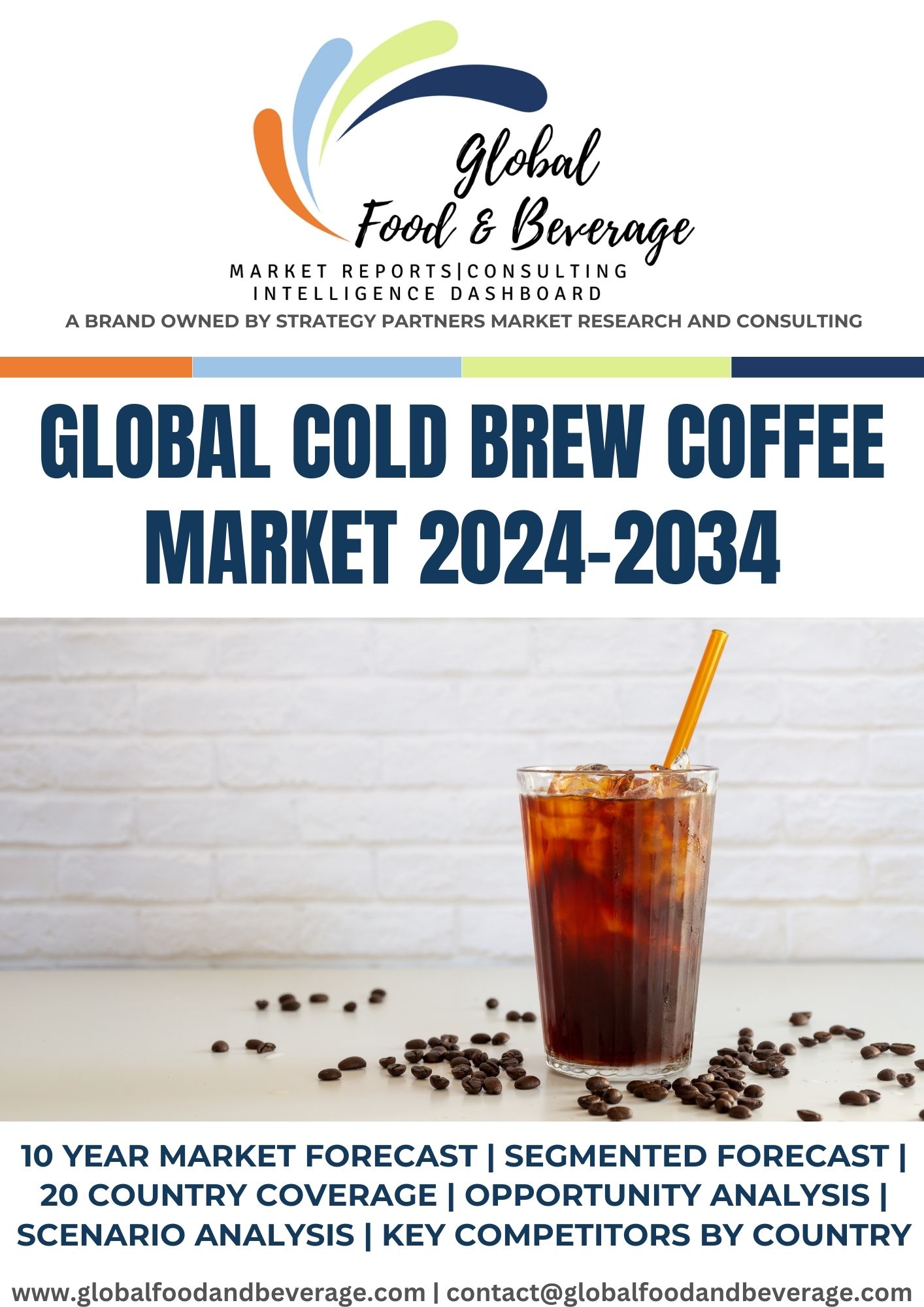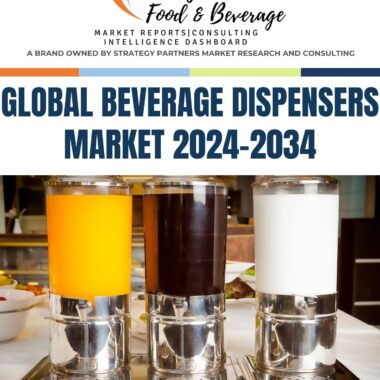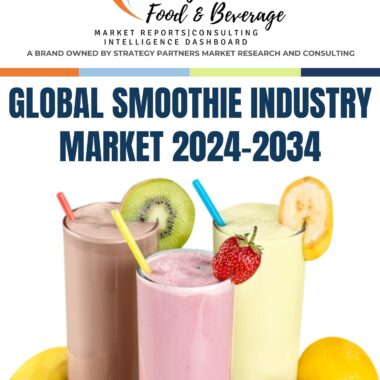Description
Cold brew coffee is a type of coffee that is made by steeping ground coffee in cold water for 12-24 hours. This results in a coffee that is less acidic and has a smoother flavor than coffee that is brewed with hot water. Cold brew coffee is also higher in caffeine than coffee that is brewed with hot water.
The key trends driving the growth of the global cold brew coffee market include:
Increasing demand for cold brew coffee from the food and beverage industry: The food and beverage industry is the largest consumer of cold brew coffee. Cold brew coffee is used in a variety of food and beverage products, including coffee drinks, smoothies, and iced tea. The growing demand for processed foods and beverages is driving the demand for cold brew coffee.
Growing awareness of the health benefits of cold brew coffee: Cold brew coffee is a good source of antioxidants and other nutrients. Cold brew coffee has also been shown to have a number of health benefits, such as improving energy levels, reducing the risk of cancer, and boosting the immune system. The growing awareness of the health benefits of cold brew coffee is driving the demand for cold brew coffee.
Rising disposable incomes in developing countries: The rising disposable incomes in developing countries are leading to increased demand for cold brew coffee. Consumers in developing countries are increasingly demanding high-quality and nutritious food and beverage products.
The key product segments in the global cold brew coffee market include:
Ready-to-drink (RTD) cold brew coffee: RTD cold brew coffee is the largest product segment in the global cold brew coffee market. RTD cold brew coffee is cold brew coffee that has been packaged and is ready to drink. RTD cold brew coffee is a convenient and popular option for consumers who are looking for a quick and easy way to enjoy cold brew coffee.
Concentrated cold brew coffee: Concentrated cold brew coffee is the second largest product segment in the global cold brew coffee market. Concentrated cold brew coffee is cold brew coffee that has been reduced to a syrup or concentrate. Concentrated cold brew coffee is a popular option for consumers who want to make their own cold brew coffee at home or who want to add cold brew coffee to other recipes.
Cold brew coffee grounds: Cold brew coffee grounds are the third largest product segment in the global cold brew coffee market. Cold brew coffee grounds are coffee grounds that have been specifically ground for cold brewing. Cold brew coffee grounds are a popular option for consumers who want to make their own cold brew coffee at home.
The key distribution channels in the global cold brew coffee market include:
Direct sales: Direct sales are the largest distribution channel for cold brew coffee. Direct sales involve manufacturers selling cold brew coffee directly to food and beverage companies, retailers, and other distributors.
Distributors: Distributors are another important distribution channel for cold brew coffee. Distributors purchase cold brew coffee from manufacturers and sell it to food and beverage companies, retailers, and other distributors.
Online retailers: Online retailers are also becoming an important distribution channel for cold brew coffee. Online retailers sell cold brew coffee to food and beverage companies, retailers, other distributors, and directly to consumers.
The key challenges facing the global cold brew coffee market include:
Regulatory challenges: The regulation of cold brew coffee varies from country to country. This can make it difficult for cold brew coffee manufacturers to market their products globally.
Health concerns: There have been some concerns about the health risks of cold brew coffee, particularly when it is consumed in high quantities. These concerns have led to increased scrutiny of the cold brew coffee industry.
Lack of awareness of cold brew coffee: Some consumers are not aware of cold brew coffee or the health benefits it offers. This can make it difficult for cold brew coffee manufacturers to market their products to consumers.
Despite the challenges, the global cold brew coffee market is expected to continue to grow in the coming years. This is due to the increasing demand for cold brew coffee from the food and beverage industry, the growing awareness of the health benefits of cold brew coffee, and the rising disposable incomes in developing countries.
Here are some additional thoughts on the global cold brew coffee market:
The market for organic and natural cold brew coffee is growing rapidly. This is due to the increasing demand
Table of Content
1 Market Introduction- Global Cold Brew Coffee Market
1.1 Market Segmentation- Global Cold Brew Coffee Market
1.2 Key Trends- Global Cold Brew Coffee Market
1.2.1 Drivers
1.2.2 Restraints
1.2.3 Challenges
2 Global Market Forecast- Global Cold Brew Coffee Market
2.1.1 By Region
2.1.2 By Product
2.1.3 By Category
2.1.4 By Distribution Channel
3 Country Wise Forecast- Global Cold Brew Coffee Market
3.1 US
3.1.1 Key Trends
3.1.2 Consumer Spending
o Population
o GDP
o CPI
o Spend per Capita
o Spend as a proportion of GDP
3.1.3 Market Forecast- US Cold Brew Coffee Market
o By Product
o By Category
o By Distribution Channel
3.1.4 Key Competitors- US Cold Brew Coffee Market
3.1.5 EXIM
3.1.6 Patents
3.1.7 Scenario Analysis- US Cold Brew Coffee Market
3.1.8 Opportunity Analysis- US Cold Brew Coffee Market
3.2 Canada
3.2.1 Key Trends
3.2.2 Consumer Spending
o Population
o GDP
o CPI
o Spend per Capita
o Spend as a proportion of GDP
3.2.3 Market Forecast- Canada Cold Brew Coffee Market
o By Product
o By Category
o By Distribution Channel
3.2.4 Key Competitors
3.2.5 EXIM
3.2.6 Patents
3.2.7 Scenario Analysis
3.2.8 Opportunity Analysis
3.3 UK
3.3.1 Key Trends
3.3.2 Consumer Spending
o Population
o GDP
o CPI
o Spend per Capita
o Spend as a proportion of GDP
3.3.3 Market Forecast
o By Product
o By Category
o By Distribution Channel
3.3.4 Key Competitors
3.3.5 EXIM
3.3.6 Patents
3.3.7 Scenario Analysis
3.3.8 Opportunity Analysis
3.4 Germany
3.4.1 Key Trends
3.4.2 Consumer Spending
o Population
o GDP
o CPI
o Spend per Capita
o Spend as a proportion of GDP
3.4.3 Market Forecast
o By Product
o By Category
o By Distribution Channel
3.4.4 Key Competitors
3.4.5 EXIM
3.4.6 Patents
3.4.7 Scenario Analysis
3.4.8 Opportunity Analysis
3.5 France
3.5.1 Key Trends
3.5.2 Consumer Spending
o Population
o GDP
o CPI
o Spend per Capita
o Spend as a proportion of GDP
3.5.3 Market Forecast
o By Product
o By Category
o By Distribution Channel
3.5.4 Key Competitors
3.5.5 EXIM
3.5.6 Patents
3.5.7 Scenario Analysis
3.5.8 Opportunity Analysis
3.6 Italy
3.6.1 Key Trends
3.6.2 Consumer Spending
o Population
o GDP
o CPI
o Spend per Capita
o Spend as a proportion of GDP
3.6.3 Market Forecast
o By Product
o By Category
o By Distribution Channel
3.6.4 Key Competitors
3.6.5 EXIM
3.6.6 Patents
3.6.7 Scenario Analysis
3.6.8 Opportunity Analysis
3.7 Ireland
3.7.1 Key Trends
3.7.2 Consumer Spending
o Population
o GDP
o CPI
o Spend per Capita
o Spend as a proportion of GDP
3.7.3 Market Forecast
o By Product
o By Category
o By Distribution Channel
3.7.4 Key Competitors
3.7.5 EXIM
3.7.6 Patents
3.7.7 Scenario Analysis
3.7.8 Opportunity Analysis
3.8 Spain
3.8.1 Key Trends
3.8.2 Consumer Spending
o Population
o GDP
o CPI
o Spend per Capita
o Spend as a proportion of GDP
3.8.3 Market Forecast
o By Product
o By Category
o By Distribution Channel
3.8.4 Key Competitors
3.8.5 EXIM
3.8.6 Patents
3.8.7 Scenario Analysis
3.8.8 Opportunity Analysis
3.9 Belgium
3.9.1 Key Trends
3.9.2 Consumer Spending
o Population
o GDP
o CPI
o Spend per Capita
o Spend as a proportion of GDP
3.9.3 Market Forecast
o By Product
o By Category
o By Distribution Channel
3.9.4 Key Competitors
3.9.5 EXIM
3.9.6 Patents
3.9.7 Scenario Analysis
3.9.8 Opportunity Analysis
3.10 Switzerland
3.10.1 Key Trends
3.10.2 Consumer Spending
o Population
o GDP
o CPI
o Spend per Capita
o Spend as a proportion of GDP
3.10.3 Market Forecast
o By Product
o By Category
o By Distribution Channel
3.10.4 Key Competitors
3.10.5 EXIM
3.10.6 Patents
3.10.7 Scenario Analysis
3.10.8 Opportunity Analysis
3.11 Sweden
3.11.1 Key Trends
3.11.2 Consumer Spending
o Population
o GDP
o CPI
o Spend per Capita
o Spend as a proportion of GDP
3.11.3 Market Forecast
o By Product
o By Category
o By Distribution Channel
3.11.4 Key Competitors
3.11.5 EXIM
3.11.6 Patents
3.11.7 Scenario Analysis
3.11.8 Opportunity Analysis
3.12 Portugal
3.12.1 Key Trends
3.12.2 Consumer Spending
o Population
o GDP
o CPI
o Spend per Capita
o Spend as a proportion of GDP
3.12.3 Market Forecast
o By Product
o By Category
o By Distribution Channel
3.12.4 Key Competitors
3.12.5 EXIM
3.12.6 Patents
3.12.7 Scenario Analysis
3.12.8 Opportunity Analysis
3.13 The Netherlands
3.13.1 Key Trends
3.13.2 Consumer Spending
o Population
o GDP
o CPI
o Spend per Capita
o Spend as a proportion of GDP
3.13.3 Market Forecast
o By Product
o By Category
o By Distribution Channel
3.13.4 Key Competitors
3.13.5 EXIM
3.13.6 Patents
3.13.7 Scenario Analysis
3.13.8 Opportunity Analysis
3.14 Brazil
3.14.1 Key Trends
3.14.2 Consumer Spending
o Population
o GDP
o CPI
o Spend per Capita
o Spend as a proportion of GDP
3.14.3 Market Forecast
o By Product
o By Category
o By Distribution Channel
3.14.4 Key Competitors
3.14.5 EXIM
3.14.6 Patents
3.14.7 Scenario Analysis
3.14.8 Opportunity Analysis
3.15 Mexico
3.15.1 Key Trends
3.15.2 Consumer Spending
o Population
o GDP
o CPI
o Spend per Capita
o Spend as a proportion of GDP
3.15.3 Market Forecast
o By Product
o By Category
o By Distribution Channel
3.15.4 Key Competitors
3.15.5 EXIM
3.15.6 Patents
3.15.7 Scenario Analysis
3.15.8 Opportunity Analysis
3.16 Australia
3.16.1 Key Trends
3.16.2 Consumer Spending
o Population
o GDP
o CPI
o Spend per Capita
o Spend as a proportion of GDP
3.16.3 Market Forecast
o By Product
o By Category
o By Distribution Channel
3.16.4 Key Competitors
3.16.5 EXIM
3.16.6 Patents
3.16.7 Scenario Analysis
3.16.8 Opportunity Analysis
3.17 China
3.17.1 Key Trends
3.17.2 Consumer Spending
o Population
o GDP
o CPI
o Spend per Capita
o Spend as a proportion of GDP
3.17.3 Market Forecast
o By Product
o By Category
o By Distribution Channel
3.17.4 Key Competitors
3.17.5 EXIM
3.17.6 Patents
3.17.7 Scenario Analysis
3.17.8 Opportunity Analysis
3.18 Indonesia
3.18.1 Key Trends
3.18.2 Consumer Spending
o Population
o GDP
o CPI
o Spend per Capita
o Spend as a proportion of GDP
3.18.3 Market Forecast
o By Product
o By Category
o By Distribution Channel
3.18.4 Key Competitors
3.18.5 EXIM
3.18.6 Patents
3.18.7 Scenario Analysis
3.18.8 Opportunity Analysis
3.19 India
3.19.1 Key Trends
3.19.2 Consumer Spending
o Population
o GDP
o CPI
o Spend per Capita
o Spend as a proportion of GDP
3.19.3 Market Forecast
o By Product
o By Category
o By Distribution Channel
3.19.4 Key Competitors
3.19.5 EXIM
3.19.6 Patents
3.19.7 Scenario Analysis
3.19.8 Opportunity Analysis
3.20 Japan
3.20.1 Key Trends
3.20.2 Consumer Spending
o Population
o GDP
o CPI
o Spend per Capita
o Spend as a proportion of GDP
3.20.3 Market Forecast
o By Product
o By Category
o By Distribution Channel
3.20.4 Key Competitors
3.20.5 EXIM
3.20.6 Patents
3.20.7 Scenario Analysis
3.20.8 Opportunity Analysis
3.21 South Korea
3.21.1 Key Trends
3.21.2 Consumer Spending
o Population
o GDP
o CPI
o Spend per Capita
o Spend as a proportion of GDP
3.21.3 Market Forecast
o By Product
o By Category
o By Distribution Channel
3.21.4 Key Competitors
3.21.5 EXIM
3.21.6 Patents
3.21.7 Scenario Analysis
3.21.8 Opportunity Analysis
3.22 Thailand
3.22.1 Key Trends
3.22.2 Consumer Spending
o Population
o GDP
o CPI
o Spend per Capita
o Spend as a proportion of GDP
3.22.3 Market Forecast
o By Product
o By Category
o By Distribution Channel
3.22.4 Key Competitors
3.22.5 EXIM
3.22.6 Patents
3.22.7 Scenario Analysis
3.22.8 Opportunity Analysis
3.23 Malaysia
3.23.1 Key Trends
3.23.2 Consumer Spending
o Population
o GDP
o CPI
o Spend per Capita
o Spend as a proportion of GDP
3.23.3 Market Forecast
o By Product
o By Category
o By Distribution Channel
3.23.4 Key Competitors
3.23.5 EXIM
3.23.6 Patents
3.23.7 Scenario Analysis
3.23.8 Opportunity Analysis
3.24 Singapore
3.24.1 Key Trends
3.24.2 Consumer Spending
o Population
o GDP
o CPI
o Spend per Capita
o Spend as a proportion of GDP
3.24.3 Market Forecast
o By Product
o By Category
o By Distribution Channel
3.24.4 Key Competitors
3.24.5 EXIM
3.24.6 Patents
3.24.7 Scenario Analysis
3.24.8 Opportunity Analysis
4 Opportunity Matrix- Global Cold Brew Coffee Market
5 Conclusions and Recommendations- Global Cold Brew Coffee Market
6 About Global Food & Beverage




